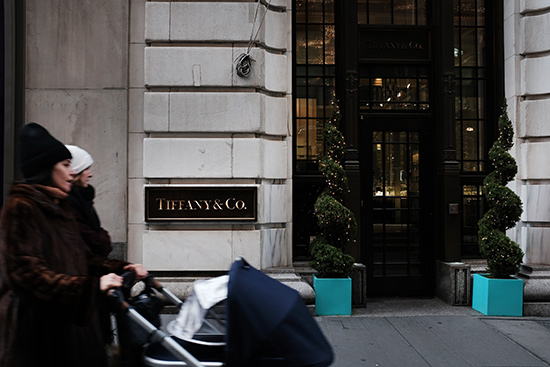有路威酩轩加持,蒂芙尼有望成为真正的奢侈品品牌

|
路威酩轩终于让蒂芙尼点头了,于是在11月25日宣布,以162亿美元的价格收购这家标志性的纽约珠宝商。 这是奢侈品行业迄今最大的一笔交易,将会推动法国巨头路威酩轩的珠宝业务,它在这一块业务上一直落后于瑞士对手历峰集团。 如果路威酩轩能够成功提升蒂芙尼不大不小的业务规模的话,潜力还不止于此。 路威酩轩以其庞大的资源,可以让蒂芙尼——它拥有183年历史,最为标志性的是蛋壳蓝盒子、订婚珠宝以及因1961年经典电影《蒂芙尼的早餐》而出名的曼哈顿第五大道旗舰店——成为它一直梦寐以求的全球性的奢侈珠宝商。 蒂芙尼有一些见不得人的小秘密:它实际上不能算一个真正的奢侈品牌,比如哈里·温斯顿和卡地亚那类。它确实也卖高达138000美元一条的项链和成吨的钻石,但其收入的30%来自相对便宜的银饰品,给人们的观感是蒂芙尼主要是卖大众产品的,也就比Zales和Kay高档一点点。 路威酩轩有着带领品牌提升的良好记录,这也告诉了我们它会怎么提升蒂芙尼。2011年时,路威酩轩收购了意大利的珠宝商宝格丽,重视推广该品牌的历史传承和耀目产品,让宝格丽重焕生机。从彭博新闻提供的业绩数据看,宝格丽的营收翻倍。值得一提的是,蒂芙尼的首席执行官亚历桑德罗·博格里奥罗,职业生涯早期曾经在宝格丽工作过。(收购后博格里奥罗是否会留任的问题,蒂芙尼没有立即给出答复。) 路威酩轩还可以帮助蒂芙尼把手表业务的潜力发挥出来。2015年,在结束了与斯沃琪的长期伙伴关系后,蒂芙尼重新推出了男款手表业务,至少试图这么做。公司主管们指望着蒂芙尼在制表上的历史荣耀能够帮助取信于大买家们,并让蒂芙尼重登手表业务舞台。(1868年,蒂芙尼造出了美洲大陆的第一款跑表。)但从去年的业绩看,尽管费尽心力,钟表类业务仅占公司44亿美元销售额的1%。 路威酩轩旗下拥有泰格豪雅、尚美、宇舶和真力时等多个手表品牌,将很可能帮助蒂芙尼扩大手表业务,并进入蒂芙尼尚未涉及的女款手表领域。 在拥抱电商业务方面,蒂芙尼的步伐也显缓慢。虽然蒂芙尼也与Farfetch之类的平台合作,但在去年,算上电话销售订单,非实体店的销售只占蒂芙尼整体销售额的7%,之前的两年也是同样比例。路威酩轩的能量,应该能够帮助蒂芙尼扩展电商业务。 作为一家国际性奢侈品巨头,毫无疑问路威酩轩可以帮助蒂芙尼最终成为一个真正的全球性品牌,而不是一家试图在国外扩展的美国公司。1837年成立于纽约的蒂芙尼,仍旧高度依赖美国国内市场,有41%的销售来自本土。(这其中又有10%来自那标志性的第五大道旗舰店。)而在美洲大陆的销售额中,有90%来自美国,今年上半财年,蒂芙尼在美洲的销售额下跌了4%。 蒂芙尼在美国的扩展主要是在郊区商场里开实体店,有些店的布置称不上是奢侈品店的布局。 一位华尔街分析师认为,蒂芙尼应该关闭一些美国的实体店,作为一家不再需要作出季度业绩报告的公司,这么做是比较容易的。蒂芙尼“在非美国市场的效率更高,可以反观该如何提高在美国的效率,并把实体店的布局合理化,” Cowen公司的一位分析师奥利弗·陈写道。 另外,路威酩轩在欧洲的资源和对欧洲市场的深刻了解,将帮助蒂芙尼最终掌握欧洲市场,这个市场是奢侈品行业的基石。上半年蒂芙尼在欧洲的销售下跌了4%,即便是长期的增长源亚洲,蒂芙尼的业务表现也是喜忧参半。而旗下拥有包括路易威登、克里斯汀·迪奥和纪梵希等多达75个品牌的路威酩轩——业务范围覆盖从服装到酒类到珠宝——懂得如何在中国扩张,以及选择最佳地产。 或许最重要的是,路威酩轩的资源和运作能力,可以帮助蒂芙尼盈利更多。蒂芙尼的法国竞争对手奢侈品珠宝商卡地亚,其特色是推出新产品以及更能赢得新客户,号称运营利润是蒂芙尼的两倍。 根据将在2020年中达成的收购交易的条款,如果蒂芙尼的股东在协议上签字,路威酩轩同意支付每股135美元,或以此价格上溢37%,之后在上月媒体就报道了这笔潜在的交易。(财富中文网) 译者:宣峰
|
LVMH has finally gotten Tiffany & Co. to say yes, announcing a deal on November 25 to buy the iconic New York jeweler for $16.2 billion. The deal, the largest ever in the luxury goods industry, will bolster the French conglomerate’s jewelry business, which has long lagged that of Swiss rival Richemont. But the potential upside goes further than that if LVMH succeeds in improving Tiffany’s middling business performance. LVMH and its massive resources could turn Tiffany—an 183-year-old company iconic for its robin egg blue boxes, engagement jewelry, and the Fifth Avenue flagship in Manhattan made famous in the classic 1961 motion picture “Breakfast at Tiffany’s”—into the kind of global luxury jeweler it has long striven to be. Here is Tiffany’s dirty little secret: It’s not really a luxury brand like, say, a Harry Winston or a Cartier. Sure, it sells $138,000 necklaces and tons of diamonds. But about 30% of its revenue comes from relatively inexpensive silver items, giving Tiffany something of a mass product image in a big part of its business that’s only a couple of notches above a Zales or a Kay Jewelers. LVMH has a good track record of taking a brand upmarket and that will inform what it does to lift Tiffany up. In 2011, it bought Italian jeweler Bulgari and focused on that brand’s heritage and standout products, restoring its aura. As a result, revenue has doubled, according to Bloomberg News. It’s worth noting that Tiffany CEO Alessandro Bogliolo worked at Bulgari earlier in his career. (Tiffany did not immediately respond to a question about whether Bogliolo will stay.) Watches are another area where LVMH can help Tiffany finally reach its potential. In 2015, the company relaunched its men’s watch business, or at least tried to, after a long partnership with Swatch fell apart. Executives were hopeful Tiffany’s previous history in watchmaking would lend it credibility with big spenders and make it a player again. (In 1868, Tiffany made the first stopwatch in America.) But last year, for all of those efforts, timepieces still only generated 1% of the company’s $4.4 billion in sales. LVMH, which owns watch brands TAG Heuer, Chaumet, Hublot, and Zenith, will likely help Tiffany bolster that business and get into women’s watches, where Tiffany is absent. Tiffany was also slow to embrace e-commerce, though it has sought to address that with partnerships such as the one it has with Farfetch. Last year, including orders by telephone, non-store orders only generated 7% of Tiffany sales, the same percentage as the two prior years. LVMH’s firepower should help it finally build up its e-commerce further. As a major international luxury conglomerate, LVMH can arguably help Tiffany finally become a true global player, rather than an American company trying to branch out abroad. Tiffany, founded in New York in 1837, is still highly dependent on the domestic market, getting about 41% of sales there. (About 10 percentage points of that comes from its iconic Fifth Avenue flagship.) But sales in the Americas, 90% of which come from the U.S., fell 4% in the first half of the current fiscal year. Much of Tiffany’s U.S. expansion has centered on opening stores in suburban malls, some of which don’t quite reach the status of a luxury space. One Wall Street analyst said Tiffany could close some U.S. stores, something easier to do as a company no longer required to report quarterly results. Tiffany’s “productivity is better in non-U.S. markets which could indicate opportunity to raise productivity in the U.S. and rationalize square footage,” Cowen analyst Oliver Chen wrote in a note. In addition, LVMH’s resources and deep understanding of Europe might help Tiffany finally master that market, the bedrock of the luxury industry. Sales in that market were down 4% in the first half. Even in Asia, long a source of growth for Tiffany, business has been a mixed bag. LVMH, whose massive portfolio of 75 brands includes the likes of Louis Vuitton, Christian Dior, and Givenchy—and ranges from clothing to alcohol to jewelry—knows how to expand in China and choose the best real estate. And perhaps most crucially, LVMH’s resources and operational prowess might help Tiffany become more profitable. Rival French luxury jeweler Cartier, which has been more deft at launching new products and more successful at winning new shoppers, boasts operating profit margins twice those of Tiffany. According to terms of the deal, expected to close in mid-2020, LVMH agreed to pay $135 per share, or a 37% premium above the price before media reports surfaced about a potential deal last month, if Tiffany shareholders sign off on the deal. |













